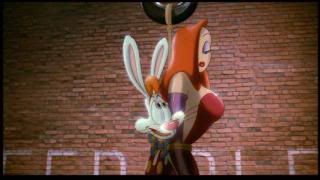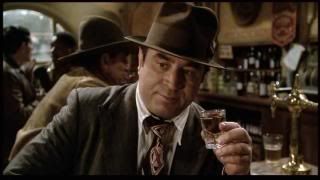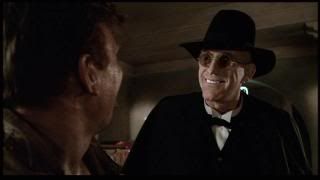Sure, the special effects in Avatar were astounding, mixing live action and computer animated footage in an organic and fluid way that I can only imagine made George Lucas wet his pants. But even with all of that sound and fury (and Academy Awards), it doesn't touch my favorite mix of film and animation. That would be Robert Zemeckis' somewhat unlikely pairing of cartoon zaniness and film noir in Who Framed Roger Rabbit, which holds up surprisingly well for a film released in 1988 (and without the luxury of computer assistance). In many ways the final word on traditional hand-drawn animation, the film proved to be an instant smash for both children and adults.
Eddie Valiant (Bob Hoskins) is a private investigator in 1940s Los Angeles who specialized in Toontown, the section of L.A. which houses the characters that populate the cartoons of Disney, Warner Brothers, Tex Avery and Maroon Cartoons. Unfortunately, after a Toon kills his brother, he abandons working for cartoons totally, scraping a living together between bottles of booze. That is, until he's paid to take some photos of the wife of Maroon Cartoon star Roger Rabbit playing patty cake with novelty impresario Marvin Acme (Stubby Kaye). After Acme is bumped off, Roger is the number one suspect and comes to Valiant for help. What follows is a tale of sex, lies and toons as Valiant goes up against the the wicked Judge Doom (Christopher Lloyd), who has his own ideas about the future of Toontown.
Surprisingly adult in both tone and content, Who Framed Roger Rabbit could have easily become a rapidly dated technical exercise (like so many mid-90s CGI-laden films), but instead finds a near perfect balance between zany, cartoon assisted sight gags and shadowy, Chinatown-like noir. In fact, Chinatown is a good reference point as the central conspiracy of removing Toontown to build a freeway has echoes in Chinatown's irrigation plot. While still accessible to children, I'll admit that the seven year old version of me didn't understand all of the intricacies of the script, which made revisiting it quite a treat.
Much of the credit of the film's success has to be given to animation director Richard Williams who was able to present all of the famous characters at their very best (producer Steven Spielberg worked out the deals with the various character owners, which is quite a feat in itself), while also creating new characters that could successfully stand along side them. Roger combines the look of several characters along with the exaggerated spit-takes of Tex Avery cartoons, into an appealingly silly everyman character, while Charles Fleischer does a great job bringing him to life with his trademark speech impediment. The sheer never of effects involved, and the amount of detail (including shadows) to allow for the moving camera - necessary to keep things cinematic - are staggering.
The acting is solid across the board. Bob Hoskins has the herculean task of acting (and physically interacting) with nothing, while still adequately hiding his prominent Cockney accent and slipping into the character of the classic Sam Spade gumshoe. While his accent occasionally slips, he makes for a terrifically ornery detective. The villainous Judge Doom is brought to life with creepy eccentricity by Christopher Lloyd, channeling his Buckaroo Banzai role as he dispatches toons with cold efficiency. Supporting performances are great, with the cartoon voice work (featuring veterans like Mel Blanc, and original voice for Betty Boop Mae Questel) mixing well with the grizzled live actors.
But in the end it's the cinematic originality of director Robert Zemeckis<, along with writers Jeffrey Price and Peter S. Seaman (adapting from a book by Gary K. Wolf), who manage to make this film work. As stated in the special features, this was really three films in one: a noir detective story, a feature length cartoon, and a special effects comedy - and it's a testament to Zemeckis' post-Back To The Future confidence that all three come off so well. The sheer amount of planning (represented by hundreds of concept drawings available on the DVD) that went into the film is boggling.
Previously released on DVD in a bare bones edition, the Vista Special edition is a marked improvement and goes all out with special features, despite some confusing choices. The oddest decision was to make this a two disc edition with a "family friendly" fullscreen version on the first disc (along with a slew of kid-friendly special features), while the Widescreen 1.85:1 "Enthusiast" edition is on the second. While I like the idea of the special features, I'm fairly certain that even young children are used to widescreen images at this point.
The first disc includes the three Roger Rabbit short films originally created to go before other Disney (and Touchstone Pictures) features. Tummy Trouble, Rollercoaster Rabbit and Trail Mix-Up are all fine tributes to traditional cartoon violence and feature some really high quality animation - particularly Rollercoaster Rabbit (directed by The Lion King's Rob Minkoff), which might be the best of the bunch. There's also a 10 minute long behind-the-scenes look at the creation of the film hosted by Charles Fleischer called Who Made Roger Rabbit. It's fluff, but for youngsters wanting to get a basic idea of how the film was made it's a breezy watch. Also included is a DVD game included called Trouble In Toontown. These are never any good, but it's an ok diversion and includes more voice work from Fleischer. Trailers for Schoolhouse Rock and Ultimate X (an X-Games documentary) round off the first disc.
The meat of the special features is on Disc 2, and obvious care has gone into covering almost any topic a Roger Rabbit enthusiast might be interested in. Some mention should be made of the DVD menus which feature new footage of the Benny The Cab character traveling around Maroon Studios. First off is a newly recorded full length audio commentary featuring Robert Zemeckis, Frank Marshall, Jeffrey Price, Peter Seaman, Steve Starkey and Ken Ralston. Despite the large number of participants, the tone is relaxed and there's a great balance between technical information and fun anecdotes and in-jokes. Thanks to those taking part continually re-introducing themselves, it also manages to avoid being confusing.
The Valiant Files is an extensive collection of concept drawings, behind-the-scenes photos and other supplementary material for the film. A famous deleted scene - where Eddie has a cartoon pig's head grafted to his own - is explored in detail. Before and after shows Bob Hoskins performing some of the most memorable Toontown scenes against bluescreen. While Toon Stand-ins shows rehearsal footage of lifesize rubber models used to give animators a sense of scope and shadow. On Set! is a brief look at a scene where Bob Hoskins is travelling inside of Benny The Cab, and some of the difficulties involved with filming without having the luxury of physical characters.
Finally, we have the 35 minute long documentary Behind The Ears, which is a fascinating look at the making of the film including new interviews with almost all of the major players, as well as lots of behind-the-scenes footage. Most interesting is clips from the original test film which convinced executives to greenlight the film. And then there's Toontown Confidential, a trivia subtitle track that gives a constant stream of interesting facts and information. These two features (combined with the commentary) feature a lot of repeated information and stories, but all are worthwhile and filled with interesting information.
Finally, we have the 35 minute long documentary Behind The Ears, which is a fascinating look at the making of the film including new interviews with almost all of the major players, as well as lots of behind-the-scenes footage. Most interesting is clips from the original test film which convinced executives to greenlight the film. And then there's Toontown Confidential, a trivia subtitle track that gives a constant stream of interesting facts and information. These two features (combined with the commentary) feature a lot of repeated information and stories, but all are worthwhile and filled with interesting information.

Who Framed Roger Rabbit exists in that sweet spot between children's film and adult entertainment that seems to be the most difficult target for films to hit - and can be seen as the precursor to the similarly toned Pixar films. To really appreciate the difficulty of what was pulled off here, just watch just about anything done with the core Disney or Loony Toons characters since this which never come close to reaching this level of unrestrained whimsy. A success on a number of levels, one can only wish that more children's entertainment treated its audience with such respect.















2 comments:
Oddly enough, I just watched WHO FRAMED ROGER RABBIT the other night, and it holds up particularly well (which is to say that not only has a significant amount of time passed, so that special effects and tastes have changed, but that I'm no longer viewing it as a child). What really struck me was the amount of humor that stemmed from playing with genre-conventions; Jessica Rabbit as the ultimate femme-fatale, etc.
Hoskins and Lloyd don't get enough credit for how good they were in this. A number of actors have had to act opposite, well, nothing, only to have their animated counterparts added later. And all these actors have produced some pretty lame acting. But Hoskins and Lloyd are both great, here; both provide better performances than any that show up in LOTR, the STAR WARS prequels, AVATAR, etc.
Plus, the weasels are awesome.
Also, I love how they used the plot intended for the (scrapped) third CHINATOWN movie:
"The subplot involving "Cloverleaf" was the planned story for the third chapter of a Chinatown trilogy (the trilogy was abandoned following the failure of 1990's The Two Jakes)"
Post a Comment